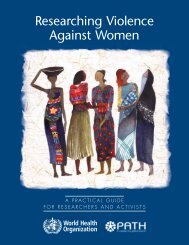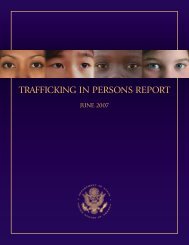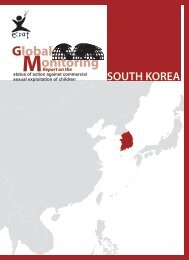Download PDF - Violence Against Children - East Asia and the ...
Download PDF - Violence Against Children - East Asia and the ...
Download PDF - Violence Against Children - East Asia and the ...
Create successful ePaper yourself
Turn your PDF publications into a flip-book with our unique Google optimized e-Paper software.
ecommendations<br />
• Emerging issues, many of which come to<br />
attention through community development<br />
activity, require response. However, many<br />
NGO staff face <strong>the</strong> choice of taking this on as<br />
an additional task when <strong>the</strong>y are already<br />
overstretched, or alternatively, ignoring an<br />
issue of exploitation. Nei<strong>the</strong>r scenario is<br />
appropriate.<br />
• Support improved project documentation<br />
systems so that key information can be made<br />
available to both internal <strong>and</strong> external<br />
audiences. Approaches to documentation are<br />
needed that allow staff to readily track<br />
changes over time <strong>and</strong> to be able to<br />
contribute to external advocacy.<br />
• Build capacity in research that incorporates<br />
child-centred approaches, so as to ga<strong>the</strong>r<br />
quality data from <strong>the</strong> perspective<br />
of children. It has been noted in ILO studies<br />
on child labour that <strong>the</strong> unit of analysis is<br />
usually an adult concern such as <strong>the</strong> family or<br />
<strong>the</strong> school, but children’s own perceptions<br />
<strong>and</strong> opinions must be taken into account.<br />
• Provide specialised technical assistance to<br />
operational offices, such as through shortterm<br />
placements to assist research, analysis<br />
<strong>and</strong> planning. This was an expressed need of<br />
some agencies interviewed for this study.<br />
Outcome-focused evaluation <strong>and</strong><br />
research<br />
• Develop local indicators on child<br />
protection, to be used in outcome-focused<br />
research.<br />
• Make links between project activities <strong>and</strong><br />
child-focused indicators, to better measure<br />
which interventions improve quality of life<br />
for children. One clear indicator used in<br />
Cambodia is increased education access, but<br />
o<strong>the</strong>r links are possible, such as a gender<br />
focus on advocacy on local child protection<br />
issues; income-generating/micro-enterprise<br />
activity <strong>and</strong> quality of life improvements; or<br />
links between alcoholism <strong>and</strong> domestic<br />
violence that affects children, as in Sri Lanka.<br />
• Conduct studies that move beyond <strong>the</strong><br />
immediate <strong>and</strong> give longer-term data on<br />
issues affecting children. Research emerging<br />
issues, document incidents <strong>and</strong> responses,<br />
<strong>and</strong> monitor impact over time, making <strong>the</strong><br />
information available to concerned parties.<br />
• Base evaluation <strong>and</strong> research on strategic<br />
child protection priorities identified by<br />
country reports on implementation of <strong>the</strong><br />
CRC. Such research may be designed <strong>and</strong><br />
implemented in partnership with o<strong>the</strong>rs,<br />
<strong>and</strong> result in published papers that include<br />
perspectives from fieldwork.<br />
• Through strategic research on child<br />
protection, develop pilot projects/<br />
models that can be scaled up <strong>and</strong> applied<br />
in o<strong>the</strong>r countries.<br />
• Document successful processes <strong>and</strong><br />
outcomes from civil society or NGO<br />
practice in promoting child protection, to<br />
allow <strong>the</strong>se approaches to be adapted in<br />
o<strong>the</strong>r settings <strong>and</strong> models to emerge; <strong>the</strong>se<br />
may be more likely to result in support<br />
from authorities <strong>and</strong>/or donors.<br />
• Gain fur<strong>the</strong>r underst<strong>and</strong>ing of specific risks<br />
to children <strong>and</strong> impacts of interventions<br />
through joint research, including in<br />
partnership with universities.<br />
• Pay attention to monitoring, analysis <strong>and</strong><br />
strategic use of information from projects<br />
that seek “less visible” structural<br />
changes. Information emerging from<br />
such projects may have significant influence<br />
<strong>and</strong> impact on practice that promotes<br />
child protection.<br />
• Research <strong>and</strong> monitor issues affecting<br />
children in order to support advocacy on<br />
law enforcement or social sector reform<br />
for child protection. Advocacy is<br />
streng<strong>the</strong>ned <strong>and</strong> made more relevant to<br />
grassroots development, by clear examples<br />
<strong>and</strong> systematic data collection.<br />
88

















